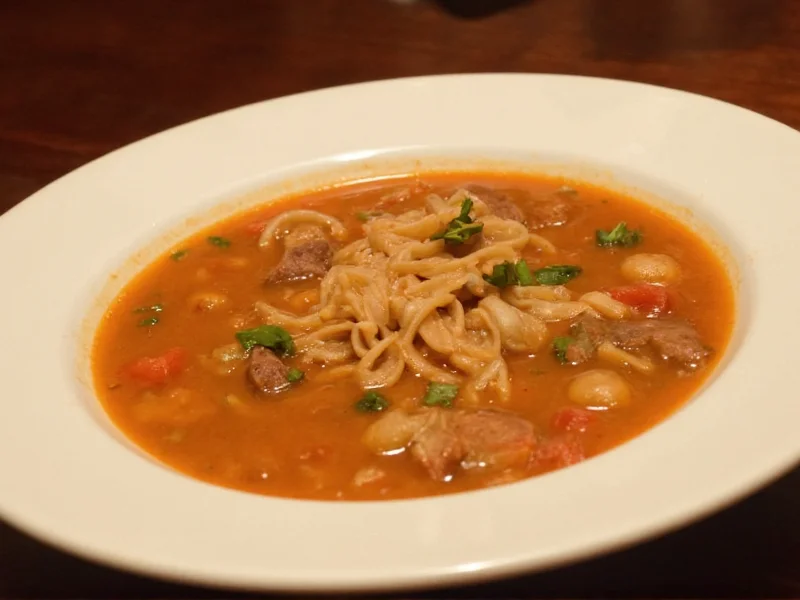The Story Behind Olive Garden's Tuscan Soup
Introduced as part of Olive Garden's limited-time menu offerings before becoming a permanent fixture, Tuscan Soup has gained a loyal following for its hearty texture and balanced flavors. Unlike traditional Italian ribollita or other Tuscan vegetable soups, Olive Garden's version features a distinctive combination of ingredients that creates a uniquely American-Italian profile. The soup's popularity has led to countless copycat recipe attempts, with home cooks seeking to recreate the comforting bowl served alongside the restaurant's signature breadsticks.
Decoding the Key Ingredients
Understanding what makes Olive Garden Tuscan Soup special requires examining each component. The foundation is a rich broth enhanced with garlic and onions, while cannellini beans provide protein and creaminess without dairy. Potatoes add thickness and heartiness, while the kale (not spinach as some believe) contributes both color and nutritional value. The subtle heat comes from red pepper flakes, not spicy sausage as many assume—the restaurant version is actually vegetarian except for the chicken broth base.
| Core Ingredient | Function in Soup | Authentic Substitute |
|---|---|---|
| Cannellini beans | Creates creamy texture | Great Northern beans |
| Kale | Provides color and nutrients | Lacinato kale (true Tuscan variety) |
| Chicken broth | Flavor base (non-vegetarian) | Vegetable broth + 1 tsp soy sauce |
| Potatoes | Natural thickener | Yukon Gold (best for creaminess) |
Authentic Homemade Recipe Guide
Creating an accurate Olive Garden Tuscan Soup copycat recipe at home requires attention to technique as much as ingredients. Start by sautéing onions and garlic until fragrant but not browned—this builds flavor without bitterness. Add broth gradually while scraping the pot bottom to incorporate all the flavorful bits. The potatoes should be cut uniformly to ensure even cooking, and the kale must be added toward the end to maintain its vibrant color and texture.
For the most authentic olive garden tuscan soup without sausage version, follow these steps:
- Sauté 1 diced onion and 3 minced garlic cloves in olive oil until translucent
- Add 6 cups vegetable broth, 2 diced potatoes, and 1 tsp red pepper flakes
- Simmer until potatoes are tender (about 15 minutes)
- Stir in 2 cans cannellini beans (drained) and 4 cups chopped kale
- Cook 5-7 minutes more until kale is tender but still bright green
- For creaminess, blend 1 cup of soup and return to pot (no dairy needed)
Nutritional Profile and Dietary Considerations
A standard restaurant serving of Olive Garden Tuscan Soup contains approximately 190 calories, 7g protein, and 8g fiber. The soup is naturally low in fat and provides significant amounts of vitamins A and C from the kale. When preparing olive garden tuscan soup vegetarian at home, you maintain these nutritional benefits while making it suitable for plant-based diets. The fiber content from beans and vegetables promotes satiety, making this a satisfying starter that won't overwhelm before your main course.
Common Recipe Mistakes to Avoid
Many home attempts at olive garden tuscan bean soup recipe fail by overcooking the kale (resulting in gray, mushy texture) or using the wrong bean variety. Cannellini beans are essential—they have a delicate flavor and creamy texture that holds up in soup. Avoid adding acidic ingredients like tomatoes too early, as this can prevent beans from softening properly. For the best olive garden tuscan soup copycat experience, add tomatoes during the last 5 minutes of cooking to preserve their fresh flavor.
Serving Traditions and Pairings
At Olive Garden, Tuscan Soup is served in a distinctive bread bowl with a side of garlic breadsticks. When recreating this experience at home, a crusty Italian bread complements the soup's earthy flavors. The restaurant typically seasons the soup tableside with black pepper and red pepper flakes—a tradition worth mimicking to let diners customize the heat level. For a complete meal, pair with a simple salad and grilled chicken.
Storage and Reheating Best Practices
Properly stored in an airtight container, homemade Tuscan Soup maintains quality for 4-5 days in the refrigerator. The flavors often improve overnight as ingredients meld. When reheating olive garden tuscan soup nutrition facts show minimal nutrient loss with gentle warming—avoid boiling, which can cause the potatoes to break down and kale to discolor. For best results, reheat on medium-low while stirring occasionally. This soup also freezes well for up to 3 months; thaw overnight in the refrigerator before reheating.
Frequently Asked Questions
Is Olive Garden Tuscan Soup actually Italian?
While inspired by Tuscan cuisine, Olive Garden's version is an American interpretation. Traditional Tuscan soups like ribollita use stale bread and different vegetables, but don't typically include creaminess from beans or potatoes in this combination.
Can I make Olive Garden Tuscan Soup vegan?
Yes, use vegetable broth instead of chicken broth and ensure all other ingredients are plant-based. The soup's creaminess comes from blended beans and potatoes, not dairy, making it naturally adaptable to vegan diets while maintaining the authentic flavor profile.
Why does my homemade version taste different from the restaurant's?
Restaurant versions use commercial broth with consistent seasoning. Home cooks can bridge this gap by using low-sodium broth and adjusting salt gradually, plus adding 1/2 tsp dried oregano and 1/4 tsp smoked paprika to enhance depth without altering the fundamental olive garden tuscan soup ingredients.
What's the best substitute for kale in this recipe?
While kale is essential for authenticity, you can use Swiss chard (stems removed) in a pinch. Avoid spinach as it wilts too quickly and changes the soup's texture. For the closest match to olive garden tuscan soup copycat kale requirements, lacinato (dinosaur) kale provides the ideal balance of tenderness and structure.
How can I make the soup thicker without adding flour?
The authentic method uses potatoes as a natural thickener. For extra body in your olive garden tuscan soup vegetarian version, blend 1-2 cups of the finished soup and return it to the pot. This technique maintains the smooth texture without altering flavor or adding unnecessary ingredients.











 浙公网安备
33010002000092号
浙公网安备
33010002000092号 浙B2-20120091-4
浙B2-20120091-4